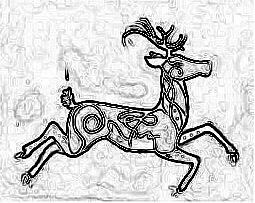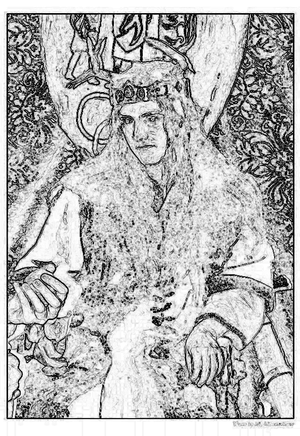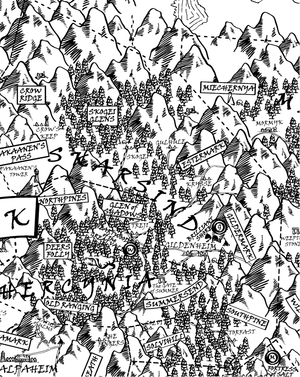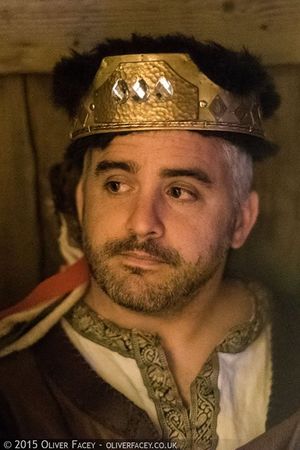Crown of Three Tears
Overview
The Crown of Three Tears was worn by the pre-Imperial kings and queens of Wintermark. It is a vital part of their heritage. It was lost to the Empire during the fall of Skarsind.
In Summer 378YE, Ioseph of Phoenix Reach (the Minister of Historical Research) commissioned an investigation into its provenance and whereabouts at the request of Thane Aedred of Renwaerd. In Autumn 381YE, the results of the research (a document prepared by the civil servant Warren of Dale) were made publicly available to Imperial scholars interested in the history of this prestigious item.
The Crown of Three Tears
The history of the Crown is innately tied to the history of Wintermark. Every child knows the story of its creation, and it can be argued that it has existed as long as the concept of Wintermark itself. The two are practically inseparable.
It is beyond the scope of this document to list every significant event involving the crown; a conservative estimate would suggest it is anywhere between five and seven hundred years old, and has been in constant use throughout this time.
Rather I will attempt to give an overview of the crowns history, and highlight events that seem particularly relevant today. I am indebted to the assistance offered by the scholars of Rundhal and Kalapheim, and to the Navarr of the Swift Quill Striding who helped gather information from historians across the Empire.
Provenance of the Crown
After the war a victory celebration was held in Hahnmark. A traditional Steinr grand moot – a Witan – was called, where three representatives of each people spoke on the nature of their achievement and of what must be done next to survive. It is said that amidst the speeches the leaders of the Suaq, the Kallavesi and the Steinr each shed a single tear for the trolls, and that these three tears froze in an instant, becoming clear gems. These gems were collected by the most cunning of the Suaq hunters and set in a crown forged from the torcs and rings of the fallen heroes of the three people. The wisest of the Kallavesi mystics crowned wily Ulmo of the Suaq King of the Three Tears, ruler of a new nation, Wintermark.
A tale of Years, '''Scop Arna the Golden'''Without wishing to give offence to the Winterfolk, the story of the three tears is almost certainly a metaphor not intended to be taken literally. As with the stories of feathers, seals and falling stars, it is a fanciful tale that appeals to the romantic nature of the folk of the north-west. The Steinr, Suaq and Kallavesi had just waged and won a bloody war of extermination against the “trolls” (most likely a metaphor themselves for a powerful nation of orcs – several books have been written about this theory so we will not belabour it here).
The story of the forging of the crown itself, however, is certainly based in fact – examination has confirmed the story of its construction. The clear gemstones are unique, as near as can be ascertained – no jeweller has ever successfully identified them as anything other than “clear gems”, nor have any other gemstones with the precise hue, tone or translucence been encountered. This alone would be sufficient to make the crown a treasure beyond price. One quirk associated with the crown is that the ritual Hand of the Maker does not reveal the identity of the jeweller who crafted the crown. Magicians who have performed that ritual on the Crown of Three Tears report that it simply presents a sensation of cold, darkness and great sadness. While some magical scholars theorise that this simply means a powerful Night ritual has been used to conceal the crafter, the magicians involved regularly point out that they can tell the difference between receiving a result they do not understand and information that is hidden by magic.
As the Crown of Wintermark
The crown was passed from monarch to monarch through the history of Wintermark; when a king or queen died the Witan would select another to take their place. The ceremonial coronation always took place at the end of the Witan, marking the chosen King or Queen as the leader – but not the ruler – of the three peoples. It is no coincidence that the method of choosing the King or Queen of Wintermark is similar to the method whereby the modern Empire chooses an Empress or Emperor – indeed, those Winterfolk who have held the Throne (Guntherm, Mariika and Britta) all delayed their coronation until the end of the summit in honour of this old Winterfolk tradition.
The list of Wintermark kings and queens is incomplete – but all existing stories confirm that they were crowned with the Crown of Three Tears. All Kallavesi, Steinr and Suaq recognise the crown – at the very least it adorns the Face of Ulmo, the massive carving of the Suaq First King that overlooks the Winterfolk “capital” of Kalpaheim.
Three monarchs in particular are worth mentioning in a document about the Crown of Three Tears.
Queen Ilsin and the Vallorn
The first is Queen Ilsin, during whose reign the crown was very nearly lost forever. Against the advice of her counsellors, she led an ill-fated crusade against the vallorn of Hercynia. Trusting to the power of her runesmiths and icewalkers, the queen and a large number of her warriors attempted to root out the infestation with fire and steel.
Perhaps predictably, the attempt was a disaster and the queen and all her warriors were reportedly slain by an onslaught of ravenous vallornspawn. Hours before her death, Queen Ilsin entrusted the Crown of Three Tears to Carun White-Walker, widely considered one of the swiftest messengers of the Navarr people at the time, and he managed to break through the tide of monstrous assailants closing in around the Wintermark army. The crown was returned to Hahnmark, and Carun's impassioned tale of the Queen's courage in the face of certain death is remembered in Kalpaheim to this day.
King Yorick and the Thrones of Summer
A little over fifty years later, the changeling King Yorick Bloodgold led the folk of Wintermark (the image here is purportedly a drawing of King Yorick found in the cellar of a house in Kalpaheim in 342YE). He wore the Crown of Three Tears to a “summit” attended by the nobles of the Summer Realm, representing the people of Wintermark. The details of the meeting are quite fanciful, and difficult to confirm. It is said that Queen Eleonaris of the Fields of Glory, Queen Cathan Canae of the Cold Wastes, Prince Jaheris the Just, King Hayaak of the Forest of Arden and King Rhianos of the Eternal Sea all greeted Yorick as an equal. They judged him to be a great ruler of people because in their eyes he rules over not one but three kingdoms. According to the tale, the crown allowed Yorick to endure the majestic presence of these five potent Eternals and gave his word great weight in their councils. During the meeting, peace was brokered between the warring Eternals – and a treaty agreed to limit the involvement of the Summer Eternals in the conflict between the Wintermark and the Jotun.
A footnote to this tale suggests that when Yorick returned from the Summer realm (presumably in reality this was a chamber somewhere between the mortal realm and the Eternal realm) he brought with him five gifts from the Eternal Kings and Queens.
A similar tale is apparently told among the Jotun, although in their case the Jarl of Jarls is credited with securing the peace treaty and receiving the five gifts.
The Last King, Alof Bearning
The last bearer of the crown was the Kallavesi Alof Bearning (a copy of the only surviving image of the king can be found to the right). He was chosen or his swift wits, clever tongue and cautious demeanour. Before his coronation, the mystics explored a powerful vision that suggested the next ruler would be called on to make a decision vital to the future of Wintermark; indeed, only six months after his coronation the First Empress held her historic meeting at Anvil. Alof attended, and while he found the Empress' vision appealing he declined the offer to forge an Empire. According to history, he saw little benefit in an alliance with the distant Highborn – another story suggests that a bitter argument between Marchers and Dawnish attendees (or between Urizen and Navarr – sources give different versions) caused him to believe that the Empire would fail because it would be unable to achieve unity.
The King was no fool however – he knew that if the Empress did unite the Bay of Catazar, even for a short time, she would be irresistible. He returned to Kalpaheim full of uncertainty and sought the advice of his counsellors.
In the end, however, the King was persuaded that the grand alliance might in fact work, in part due to the skilled diplomacy of a Highborn Wayfarer, Malachi of the Winds of Virtue. Alof personally helped lay the groundwork for the Imperial Senate, and was instrumental in ensuring that the leaders of the Empire represented the people, rather than governed them.
Finally, when the nation joined the Empire, King Alof Bearning returned the crown to the Kallavesi mystics. It became not only a symbol for the unity of the three peoples of Wintermark, but for their union with the newborn Empire.
As the Crown of Heroes
After the end of the line of Kings and Queens, the Kallavesi mystics chose to bestow the crown on the Winterfolk hero they considered to best exemplify the virtues of Wintermark. While the final decision lay with the Kallavesi – as was the will of King Arnulf – in each case the mystics took counsel from the cleverest Suaq and the most courageous Steinr. The decision was never made lightly, and it was understood that only death would sever the tie between the hero and the crown.
In the last 378 years, an estimated eighty-four citizens of Wintermark have worn the crown and stood as exemplars of Winterfolk unity. Of these, all save two held the crown until their deaths.
Lordi the Far Walker abdicated his responsibility when it became clear that the wasting sickness he suffered for most of his life would soon claim it – he returned the crown to the Kallavesi before his final Walk northwards.
Ritha Henriksdottir was the only hero of Wintermark to be stripped of the crown. During the reign of Empress Brannan she drew arms against the Cardinal of Loyalty following the shameful revocation of the Throne. Motivated by anger over what she saw as a betrayal, her hot Changeling blood caused her to murder the Cardinal in front of several dozen witnesses. She never denied the charge, and returned the crown to the Senator for Kallavesa shortly before her execution. Her final words were sometimes mentioned as a caution to the heroes that followed her: “let my shame pass with me, and leave the crown and the heart of Wintermark untouched.”
Covetousness, murder and Blood-on-the-Snow
As a priceless artefact of great power and importance to the people of Wintermark, it should come as no surprise that there have been numerous attempts to remove the crown from the hero of Wintermark to which it has been entrusted.
In 138YE, the Crown was actually stolen in 138YE by, of all things, a coven of Urizen magicians who were convinced that it held the key to unravelling a magical mystery related to the control of winter storms. They drugged the hero Marko the Ice Lion during his marriage celebration, but their attempt to replace the crown with a replica was uncovered almost immediately. The ire of the entire nation of Wintermark was raised against the Urizen – and it must be said that the aghast magicians of the south-eastern lands cooperated entirely with the resulting investigation and willingly handed the thieves over to Imperial justice. The crown was recovered, undamaged, and those involved in its theft faced stiff penalties.
In 246YE a minor diplomatic incident occurred when a representative of a powerful Asavean “noble” named Bertillon of Nemoria attempted to buy the crown, intending for it to form the centrepiece of his collection of royal regalia from around the world. After three increasingly heated attempts, the bearer of the Crown, supported by all four Wintermark senators and the egregore and with the assistance of several burly warriors ejected Bertillon's agent from Anvil. The Winterfolk were later charged with assault, and required to pay reparations to the agent – but no further attempts were made to purchase the Crown of Three Tears.
In Winter 328YE, agents of Agramant attempted to steal the Crown of Three Tears during a particularly eventful summit an Anvil. Haukr Valdísarson, the Suaq hunter who was at that time bearer of the crown was lured into an ambush and set upon by corrupt Marchers and several Heralds of the Winter Eternal. Despite the odds, he and his party fought free although in the process Haukr was fatally wounded when a bone spear-tip broke off near his heart. He died two days later.
Following his death, his son Valdir employed potent Icewalker rituals to seek the deeper purpose behind his father's murder. Pursuing several leads, he discovered the existence of a bargain between the Dream-of-Famine and a Thule Dragon called “Fraynir” who coveted the crown for an unknown purpose.
Two more attempts were made to acquire the crown that were later traced to the Thule magician – a blatant attempt to buy it by an agent of the Thrice Cursed Court in 334YE, and a Thule orc attack against the home of Karmark Ogmasdottir (Steinr hero of Wintermark) in 352YE. Kormakr was able to foil the attack against her home but lost her life in the process.
What use a Thule Dragon might have for the Crown of Three Tears is difficult to guess, but conjecture suggests that it Fraynir was likely motivated by more than simple covetousness. While the last attempt to gain the crown that can be convincingly tied to the Dragon took place nearly forty years ago, it is impossible to be certain that Fraynir is no longer alive – even if the stories of Thule Dragons having achieved a state of near immortality are not true, it is accepted fact that their lifespan is supernaturally long.
Inga Suvvisdottir and the Fall of Skarsind
The final Wintermark hero to wear the crown was Inga Suvvisdottir. This courageous warrior was killed in 373YE during the fall of Skarsind. She was killed by Thule forces while defending Gildenheim, along with the majority of the warriors fighting alongside her.
An eye-witness, the grimnir, Hovat the Bloody, says that her unit were attempting to fight through to relieve an impromptu field hospital that had been threatened by an unexpectedly successful push by the Thule. Her soldiers were ambushed by Thule archers, pinned down against the walls of Gildenheim, and surrounded by a significant force of warriors supported by a grim “empty eyed” warlock. With her companions falling left and right to remorseless attacks, Inga engaged the leader of the ambushing group - a massive pale-skinned warrior wearing midnight scale armour with a helmet in the shape of a roaring drake. She fell beneath his massive green-iron blade but not before she had inflicted a grievous wound on him.
Hovat's account lacks details – the chaos of warfare makes it difficult to confirm his story – but the when the defenders fell back before the Thule army, Inga and her warriors were not among them.
Current whereabouts of the Crown of Three Tears
After the barbarians were driven out of Skarsind in 377YE a thorough search was made of the ruins of Gildenheim in the vain hope the crown could be found – there was however no sign of it. Interrogation of captured Thule revealed very little.
At this point, we can only speculate as to the whereabouts of the crown.
It seems likely that such a potent artefact, even were it not recognised as the Throne of Three Tears, would have been claimed as part of the spoils of war. The most hopeful scenario is that it is part of the regalia of some Thule Warlock or Warlord, but unfortunately the most likely situation is that it is in the cold, withered claws of a Thule Dragon in distant Otkodov (see references to Fraynir above).
Locating and recovering the Crown of Three Tears
Had the Crown been captured by the Jotun, or even the Druj, then it might be feasible that a “ransom” could be paid to recover it. If, as is most likely, it is in the hands of the Thule it may be possible to secure its return but at this time there are no diplomatic channels with which to contact them and doing so runs the risk of alerting them to the true value of the artefact – a value they could in theory be ignorant of.
A suggestion from the Icewalker Rudhra Dancing Fox when contacted to add her expertise to the search for information about the Crown of Three Tears is that communication with an Eternal might help to confirm the location of the Crown.
The Eternal Kimus might be an obvious choice, given its interest in significant events and “pivotal”or “important” objects and people.
Alternatively, if efforts have been made to keep the whereabouts of the crown secret, then agents of the Whisper Gallery might possess some insight into where it might be found.
The final suggestion is the most worrisome of course – the crown is an immensely valuable item and, if it has fallen into the hands of a Thule Dragon, then it might have been traded to Ephisis in return for something of immense value or power … or offered as Tribute to Skathe, Tharim and Surut in return for an incalculable amount of magical power.
Properties of the Crown
The crown is very old, and has been passed down through generation after generation of Winterfolk. While it is a magical artefact, its true value lies in its symbolic nature.
It is an exceptionally powerful symbol of the unity of the three peoples. There are few items in the Empire that have such a potent symbolic meaning – the handful of items of comparative importance would include the Imperial Crown and perhaps the Throne. Its role in the history of Wintermark makes it an artefact beyond price. During the reign of Empress Mariika, the Kallavesi seer and mystic Tekupala claimed that the greatest power of the Crown was the way it warped the skein of whoever wore it. They would be drawn into situations where the choices they made would shape their destiny and that of people throughout Wintermark and beyond – but that the price paid for this shaping of the skein was that the bearer would often find themselves overwhelmed by the forces arrayed against them. Or, as the Suaq bard Garn said when he was chosen to bear the crown, that it ensured he would die a brutal, savage death at the hands of his enemies, which removed a lot of the uncertainty from his life.
Theories of Suleman of Cantiarch's Hold
The Highborn archivist Suleman of Cantiarch's Hold, made an extensive study of the bearers of the Crown of Three Tears. He petitioned to be allowed to examine the crown itself, but was politely rebuffed. Instead, he examined the lives of each of the monarchs of Wintermark and the heroes who followed them. His cautious analysis was that wearers of the crown tended to die violent deaths, usually in or shortly after battles. He suggested that the most likely explanation was that the traditions and customs of Wintermark itself meant that the kind of people wearing the crown – leaders and champions – tended to mean that they regularly found themselves in harm's way. He did note that while more bearers died violently than died peacefully (of old age or sickness), there was only one story where the bearer died of misadventure – and the death of King Ulfarn the Unready is regularly pointed to as being the result of an assassination rather than a dining accident. In the interests of balance, however, Suleman presents a second, alternative hypothesis but is quick to point out that it is just conjecture. He theorises that the Crown of Three Tears is actually an extremely dangerous cursed item; that serendipity and synchronicity conspired to put anyone bound to it in dangerous, life-threatening situations and to make it more likely they would die as a result of these encounters.
The Winterfolk cultural tendencies mean that they perceive the effect of this curse as a boon – it ensures that their leaders and heroes encounter important events during which they can make significant choices and shape their skein – and it cannot be denied that the wearers of the crown tend to live exceptional – if short and bloody – lives.
Recent History
In Winter 378YE, a curse fell over the three peoples of Wintermark that encouraged them to seek the company of their own tradition and eschew that of the other two. Initially, the Strength of Tradition was somewhat beneficial - but that soon changed as the curse grew in power and its true malignancy was revealed.
By Spring 379YE, the curse had escalated to become the Bane of Tradition, causing conflict between the three traditions and threatening to tear the nation apart. Investigation by brave heroes uncovered evidence of a conspiracy; the Thule barbarians were using the Crown of Three Tears as a powerful focus to destroy Wintermark. The crowns role as a symbol of unity made it the perfect tool to try and tear that unity apart.
The Crown was eventually recovered by Imperial heroes during a vicious engagement with Thule forces in Hahnmark, here the orcs were attempting to complete the final stage of their magic. As part of the ceremony needed to break this curse, General Erkenbrand of Tyrsholm was crowned the first champion of Wintermark since the fall of Ingvar Suvvisdottir, and the unity of Kallavesi, Steinr, and Suaq was re-affirmed.



